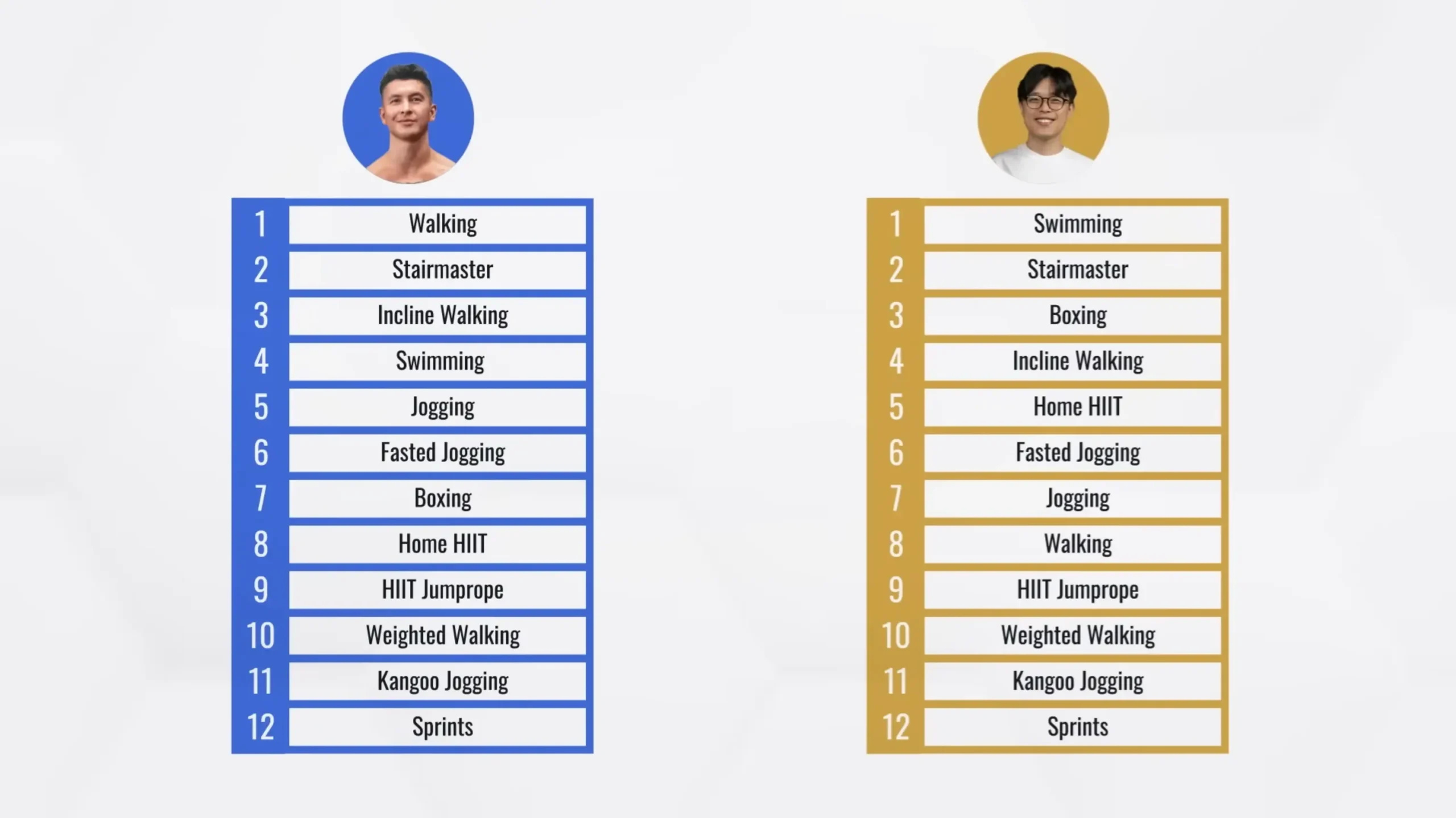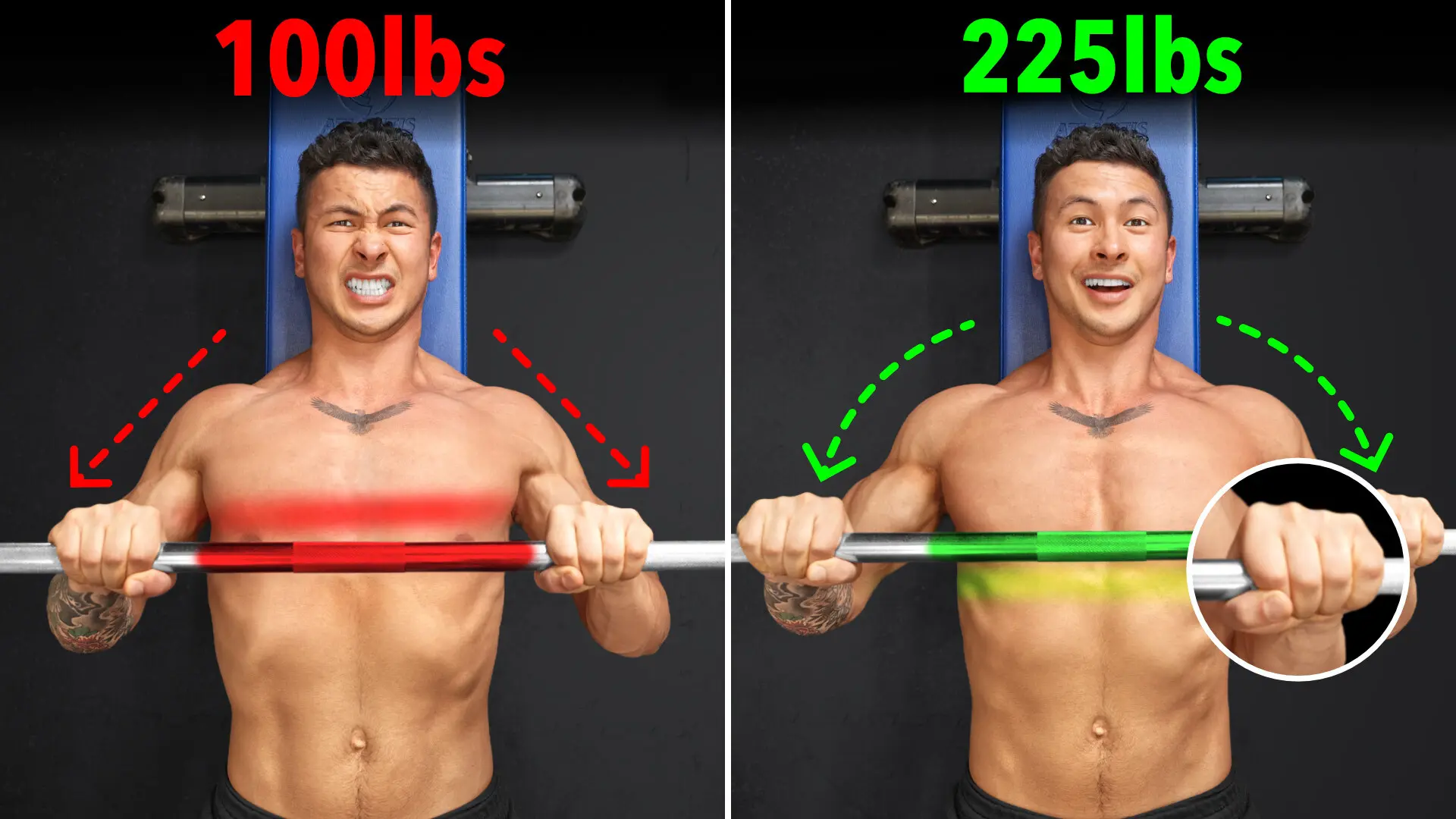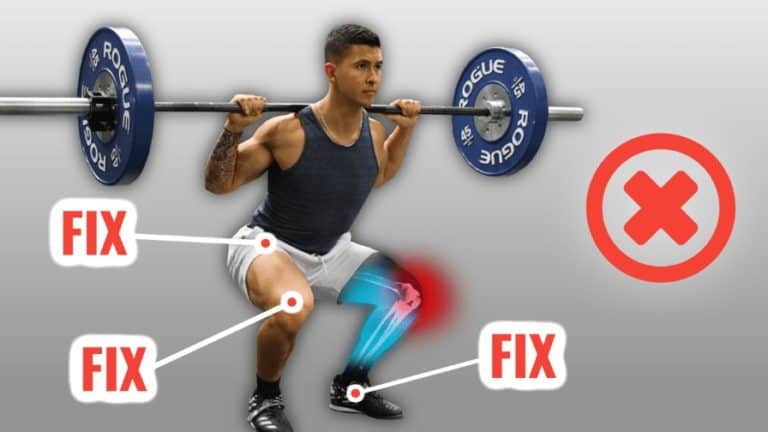
How To Squat Without Knee Pain (4 Mistakes You’re Probably Making)
If you want to learn how to get rid of knee pain when squatting for good... Then you need to read this article.
Squats are a complex exercise that allows people to target multiple muscles, primarily the quads and the glutes.

And if you want bigger legs, then your best bet is to do some form of squats in your leg workouts.
However, the squat is also known as one of the most “dangerous” exercises as many people experience knee pain when squatting or knee pain after squats. The pain can present itself as discomfort around the knee cap:
...or above/below the knee at the tendon attachment points:
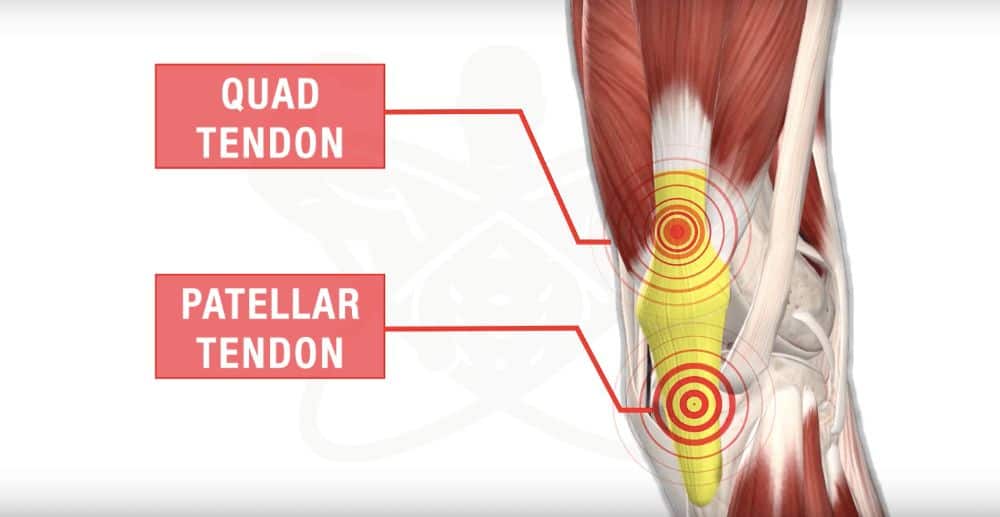
The thing is though, most people don't have "bad knees".
In fact, the pain their knees hurt when squatting due to damage around the knee because of a few common mistakes they make during the squat.
In this post, we will go through exactly what these mistakes are AND how to fix them.
In so doing, future injury can be prevented to allow you to get back into the gym and perform squats without knee pain.
A short note before we begin: as the saying goes, prevention is always better than cure. That's why I design every BWS program carefully to ensure that it does not cause unnecessary, additional stress to your knees - which can worsen pain. If you're interested in transforming your physique in the most time-efficient and safe manner:
Click the button below to take my analysis quiz to discover the best program for you:
↓
Mistake #1 - Letting Your Weight Shift Forward
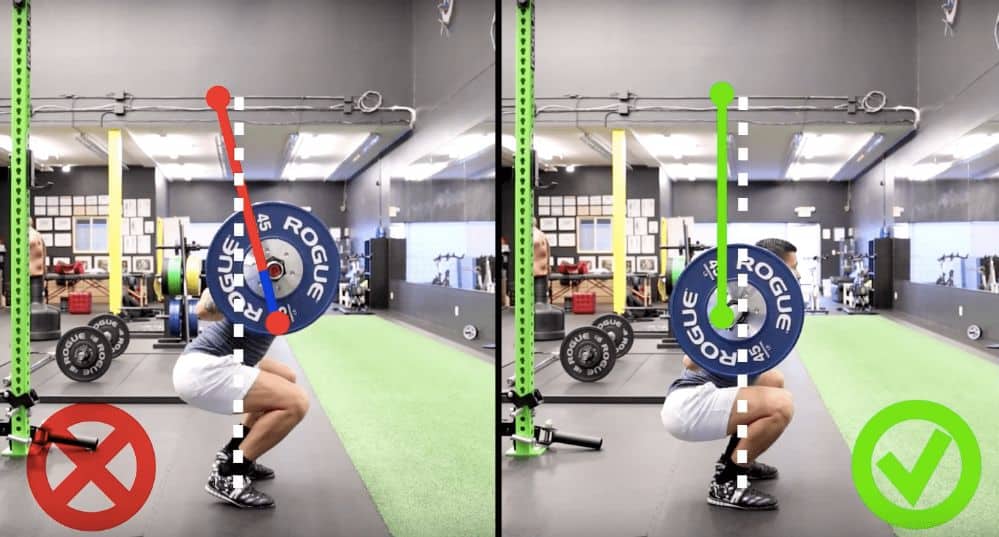
A very common mistakes people make with the squat is leaning forward and shifting the weight onto their toes. This is often accompanied by raising the heels upwards as they shift forward.
As a result, this movement error transfers more load onto the knee joint and strains the surrounding tendons.
Over time, these additional strains to the knee can manifest itself as symptoms of knee pain when squatting, especially around the knee cap.
What to do Instead
During the squat, ensure that the bar remains over your mid-foot and travels vertically up and down.

You should also apply pressure into the ground with your entire foot rather than just your toes. This will help better distribute the load onto the ankle and hip joints to prevent excessively straining the knees.
If you struggle to do this, then you may suffer from ankle stiffness.
Stiff ankles can't bend enough, forcing the body to compensates by creeping up on the toes.
To test your ankle mobility using a research validated method; you can find out if that really is the problem.
The Ankle Mobility Test
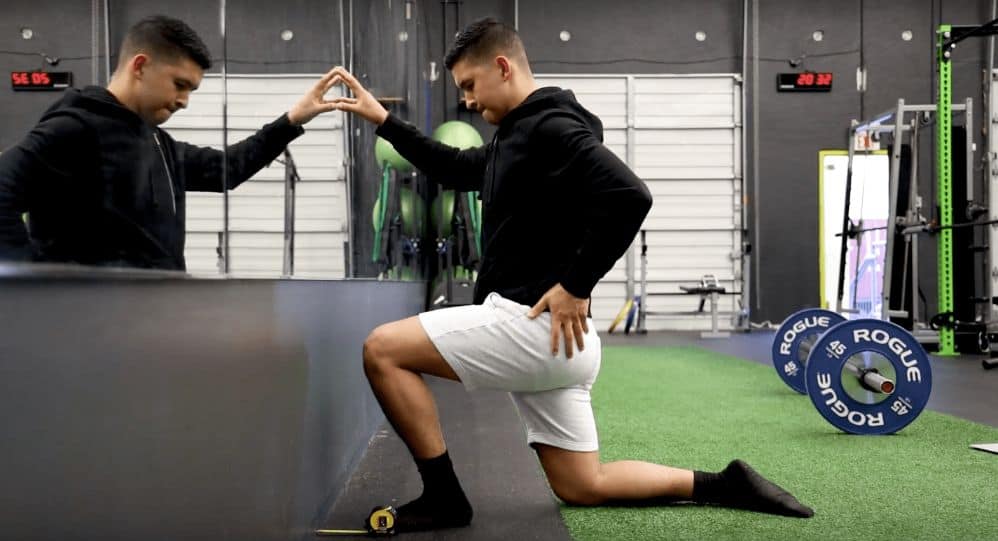
Simply kneel down by a wall without shoes on and place your toes five inches from the base.
Move your knees forward towards the wall and attempt to touch the wall without lifting your heels from the ground.

If you cannot touch the wall without your heel lifting off the ground, then we've found a weak link in your ankle mobility. Something that believe it or not, can be responsible for the knee pain you feel when squatting.
Increasing Your Ankle Mobility
This is easy enough when said, but it will take some time. I would recommend regular ankle mobility stretching in addition to foam rolling the calves and shins, especially right before you squat.
You can also experiment with a wider squat stance and/or pointing your toes out more.
These adjustments decrease the level of ankle mobility needed to properly perform a squat.
Mistake #2 - Not Actively Using The Hip Flexors
Another common mistake people make is not actively engaging the hip flexors during the squat.
Try to visualize the hip flexor muscles shown here actively pulling you into the bottom of the squat:
When you begin the squat, think about actively pulling yourself down into the bottom position. Avoid letting gravity and the weight of the bar do the work.
Engaging the hip flexor muscles stabilizes the trunk and allows you to sit deeper into the squat. It also gives you more balance, as the center of gravity is kept above your feet and results in less pressure being placed on the knees.
If you’ve never properly done this, then you’ll likely feel immediate relief in your knee pain during squats.

And to get this activation down, I'd suggest attaching a band above your head and hold onto it during the squat (see above image).
The counter resistance will force you to learn how to actively use your hip flexors to pull yourself down.
Mistake #3 - Knees and Toes Not Inline
Not properly aligning the knees with the toes during the squat can disrupt your form. This leads to inward knee collapse when squatting, also called "knee valgus".

This leads to instability in the knee which can wear away at the knee cartilage and result in pain around the knee cap during squats or after squats.
Why Does the Knee Collapse Inwards and How to Fix It?
The main reason is poor coordination and an inability to activate the lateral glutes (gluteus medius).
Luckily, fixing it is often quite simple with the use of something called RNT.
Reactive neuromuscular training or RNT, has been shown to reduce knee collapse and improve lateral glute activation.
One such exercise is the RNT split squat.

To perform it, place a resistance band around your forward foot as you perform the split squat such that it pulls your knee inwards (see the image shown above).
The resistance from the band should stimulate your lateral glutes to keep the knee in a stable position. The feet and the knees should stay aligned during the entire range of motion.
Adding 2-3 sets of 15-20 reps into your leg workouts is a great way to help teach your body to properly activate the lateral glutes. This will in turn prevent knee valgus and alleviate any pain you feel in your knees during the squat.
Admittedy, knowing how to fix muscle imbalances and 'weak points' of your body is pretty complicated. Thankfully, though, the team here at BWS has the necessary expertise to do just that. Our 3-on-1 coaching program takes the guesswork out of training, nutrition, and even mobility work - so you can focus on what matters: making gains. If you're interested:
Click the button below to find out more about the 3-on-1 coaching program:
↓
Mistake #4 - Doing Too Much Too Soon
Here's a mistake that even I've been guilty of in the past. And it's simply doing too much leg work too soon, or getting back into your usual leg workouts after you've taken time off.
Overtime, this can lead to quadriceps and/or patellar tendinopathy. If you suffer from this, you will experience knee pain pain located above or below the knee cap at the attachment point of these tendons.
The good news is that tendinopathy is easily reversible if properly managed. Research shows that these tendons recover within a few weeks if training load is significantly reduced.
How To Fix Knee Pain From Tendonitis
The best way to go about fixing your knee pain from tendonitis is to simply reduce your training load. What I'd suggest though is for you to play around with decreasing various components of your lower body workout.
By so doing, you will find which component of your workout is causing the most problems.
Then, by cutting out this component, you will begin to experience relief from the knee pain. You can also still continue to train at sufficient volumes to allow your tendons to heal and strengthen.
Suggestions for components to reduce:
- Decrease training frequency.
- Reduce load and do higher reps instead.
- Reduce number of sets
As an alternative, you can replace your regular squats with other exercises that don’t stress the knee as much.
The Box Squat: A Knee-Friendly Squat Alternative

The box squat is a great alternative to the squat for two main reasons:
- The box squat can help you control the depth to which you squat. This can effectively mitigate the point at which knee pain becomes an issue.
- Studies show that box squats elicits more vertical shin angles than regular squats. This will correspond to better pressure distribution in the foot as discussed above.

Simply meaning that if you’re struggling with knee pain during regular squats, then box squats are a great alternative.
Using other exercises can allow you increase strength in the same muscle groups that squats target to avoid knee pain when you go back to regular squats.
The Takeaway For Knee Pain When Squatting
I hope this was able to help you pinpoint what exactly might be causing your knee pain during squats.
As I always emphasize, it’s absolutely vital that you pay close attention to how exactly you perform your exercises (like the bench press and deadlift) in order to prevent injuries overtime and to progress faster. I personally could have prevented a lot of injuries and set backs had I applied this when I first started lifting.
And if you’re looking for a complete evidence-based program that’s fully equipped with in-depth tutorials for each and every movement...
...then click the button below to take the free body type analysis quiz I have up in order to discover what program is best for you:
Click the button below to take my analysis quiz to discover the best program for you:
↓
As always, thank-you for the continuous support! I always enjoy reading the questions you have posted in the comments section and implementing your suggestions!! If you have enjoyed this content, please follow me on Instagram and subscribe to my Youtube channel where I will continue to frequently post videos on a wide range of work-out related topics.


